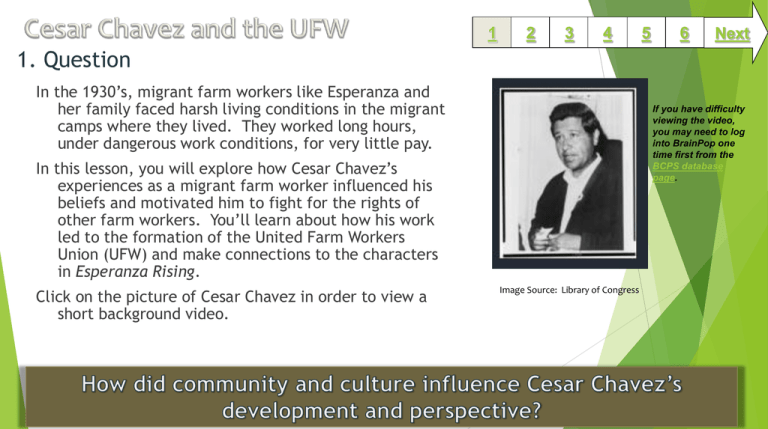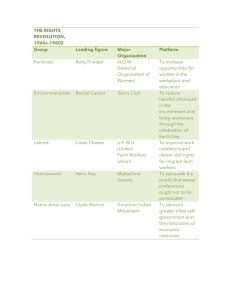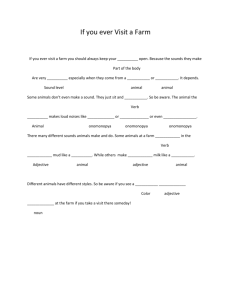
1
2
3
4
5
6
Next
1. Question
In the 1930’s, migrant farm workers like Esperanza and
her family faced harsh living conditions in the migrant
camps where they lived. They worked long hours,
under dangerous work conditions, for very little pay.
If you have difficulty
viewing the video,
you may need to log
into BrainPop one
time first from the
BCPS database
page.
In this lesson, you will explore how Cesar Chavez’s
experiences as a migrant farm worker influenced his
beliefs and motivated him to fight for the rights of
other farm workers. You’ll learn about how his work
led to the formation of the United Farm Workers
Union (UFW) and make connections to the characters
in Esperanza Rising.
Click on the picture of Cesar Chavez in order to view a
short background video.
Image Source: Library of Congress
2. Information Sources
1
2
3
4
You will use these resources to complete the Student Activity on Slide 3.
United Farm Workers Flag (Scroll down to
the bottom of the webpage.)
Biography Scroll down and click on
Biography.)
The Story of Cesar Chavez
Dream to Organize Farm Workers
Historic Victories for Unions
Image Source: Library of Congress
5
6
Next
3. Student Activity
1
2
3
4
5
6
Next
Use this graphic organizer to take
notes on the Information
Sources from Slide 2.
You will be applying this learning
to your reading of Esperanza
Rising when you complete the
Assessment Activity on Slide 4.
Image Source: Library of Congress
4. Assessment Activity
1
2
3
Using your notes, respond to the following
question:
How would Esperanza’s situation have been
different if the United Farm Workers
Union had been in place during the setting
of the novel?
You teacher may choose, or let you choose one of
the following formats to share your response:
Padlet
Voice Thread
Voki
Edmodo
Microsoft Word
Image Source: clipart.com by subscription
Your response will be scoring using this rubric or
another rubric provided by your teacher.
4
5
6
Next
5. Enrichment Activities
1
2
3
4
5
6
Learn more about the Dust Bowl, migrant
workers, and the historical setting for
Esperanza Rising, by exploring these
resources.
Dust Bowl
Dust Bowl Migration Digital Archives
Dust Bowl (video)
Interview with Florence Thompson
“The Effect of Dust Upon Health”, 1936
“Baked Out and Broke”
“Memories of the Dust Bowl” (Click on
“PDF Full Text” link when you open the article
in order to see the photos.)
Migrant farm worker, Florence Thompson.
Image Source: Library of Congress
Surviving the Dust Bowl documentary (You
may be prompted to select your local TV
station before viewing video.)
Next
6. Teacher Support Materials
1
2
3
4
5
6
Grade 6, Unit 3, Language Arts
Time Frame: 2-3 days
Common Core State Standards
Differentiation strategies for this lesson:
CCSS.ELA-Literacy.CCRA.R.1 Read closely to determine what the text says explicitly and to make logical
inferences from it; cite specific textual evidence when writing or speaking to support conclusions drawn
from the text.
CCSS.ELA-Literacy.CCRA.W.7 Conduct short as well as more sustained research projects based on
focused questions, demonstrating understanding of the subject under investigation.
CCSS.ELA-Literacy.W.6.2- Write informative/explanatory texts to examine a topic and convey ideas,
concepts, and information through the selection, organization, and analysis of relevant content.
CCSS.ELA-Literacy.W.6.7- Conduct short research projects to answer a question, drawing on several
sources and refocusing the inquiry when appropriate.
Standards for the 21st Century Learner
1.1.6 Read, view, and listen for information presented in any format (e.g. textual, visual, media,
digital) in order to make inferences and gather meaning.
2.1.3 Use strategies to draw conclusions from information and apply knowledge to curricular areas,
real-world situations, and further investigations.
ISTE NETS - National Educational Technology Standards for Students
1. Creativity and Innovation: Students demonstrate creative thinking, construct knowledge, and
develop innovative products and processes using technology. a. Apply existing knowledge to generate
new ideas, products, or processes. b. Create original works as a means of personal or group expression.
Direct students to use learning tools included
in our BCPS-licensed databases, such as:
audio read-aloud, labeled reading
levels/Lexiles, and embedded dictionaries.
Learning Styles addressed in this lesson:
Visual, Auditory, Reflective, Global, Analytical
Notes to the teacher:
Collaborate with your school library
media specialist to implement this
lesson.
Refer to these support materials, as
needed to use: Padlet, Voki, Voice
Thread, and Edmodo.
3. Research and Information Fluency: Students apply digital tools to gather, evaluate, and use
information. b. Locate, organize, analyze, evaluate, synthesize, and ethically use information from a
variety of sources and media.
Last updated: July 2014
Created by Amy L. Samay, Library Media Specialist Intern
BCPS Slam Dunk Research Model, Copyright 2013, Baltimore County Public Schools, MD, all rights reserved. The models may be used for educational, non-profit school use only.
All other uses, transmissions, and duplications are prohibited unless permission is granted expressly. This lesson is based on Jamie McKenzie’s Slam Dunk Lesson module.



